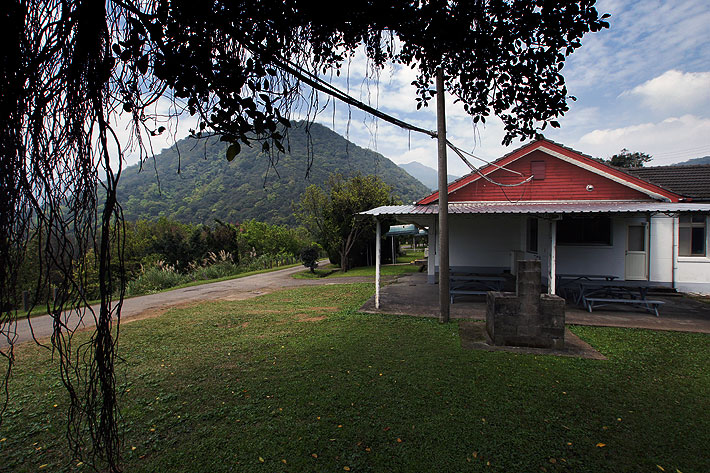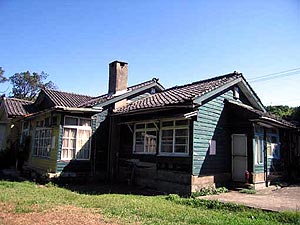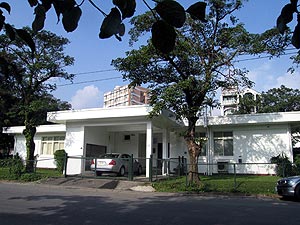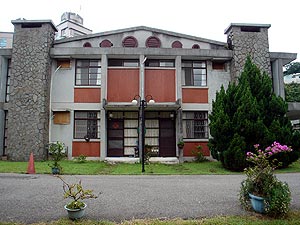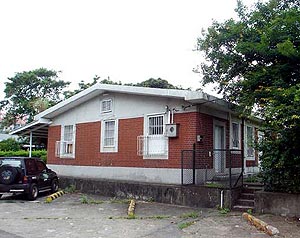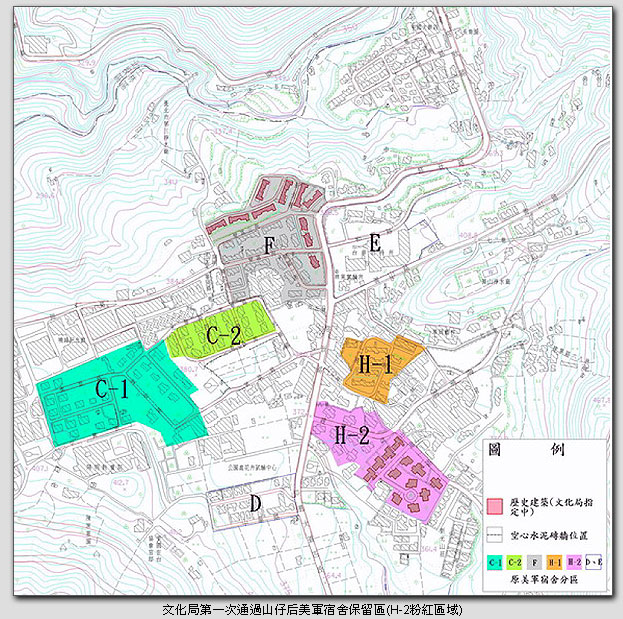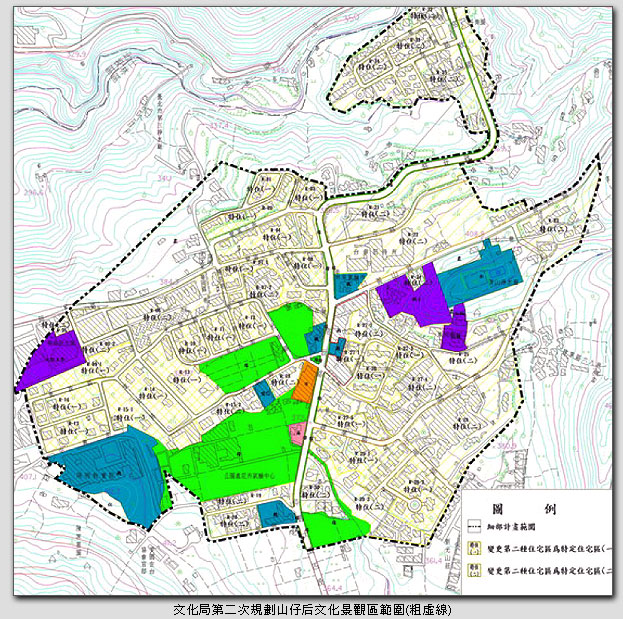In 1949, the ROC (Republic of China) government, after a succession of losses under the fierce fighting of the Chinese Civil War, crossed the sea to Taiwan. The political situation was precarious. On June 25, 1950, the Korean War broke out. The United States, which had originally decided not to intervene in the Chinese Civil War, began stationing large numbers of troops in Taiwan in order to prevent the expansion of Communist power in Asia. Under these fateful circumstances, the government, in its moment of crisis, received economic aid and was able to survive on Taiwan.
In order to settle and accommodate the American military officers and their dependents who were stationed in Taiwan, the United States consulted with the government to build housing. In 1951, members of MAAG (the United States Military Assistance Advisory Group), ROC government officials, and the architect Haigh T.H. Shen climbed aboard a helicopter. With a map of Taipei in hand, the flew around looking for a suitable place to build military dormitories. They finally decided on two sites: Tianmu, and Shanzaihou on Yangmingshan . The government ordered the Bank of Taiwan to acquire the land and begin construction.
Shanhaizou means “Back of the Mountain” in Chinese. The name comes from the fact that in order to get here from Shilin, one first has to cross the hills at Dalun. At that time, Shanhaizou was still farmland.The American military favored it for its quiet and isolation, and planned building 217 housing units. Not only was this to become the largest and most complete military dependent housing complex in Taiwan, but also the home to the highest ranking officials. The American side provided the plans for the district and the blueprints and construction standards of the houses, and the Taiwan side provided the construction. Because the Taiwan side did not have the power to change the blueprint or appearance of the houses, this area of Yangmingshan has the appearance of an American hometown landscape from the 1950s. Some architects have therefore considered these homes to be concession-style “colonial architecture.”
Unlike most of Taiwan’s narrow and crowded housing, the homes at Shanzaihou are American country style; flat single-story homes spaced about 10 to 15 meters apart from each other. Each home has a large grass covered yard, which, combined with the home itself, occupies at least 80 平 (2846 Sq Feet or 264 Sq Meters) of land. These features make the homes ideal for lighting, ventilation and privacy.
Most of the homes are not surrounded by any fencing, but rather share a comfortable grassy terrain where children can play; representative of the health and leisure of an American public space. The most distinctive features of these houses, however, are their fireplaces and chimneys. They don’t have any practical utility in Taiwan’s subtropical climate, but for the Americans who lived here, they evoked warm memories of home.
During the period the American military was stationed in Taiwan, every entrance to the complex was guarded by American military police, and non US-military personnel were prohibited from entering. This was done to protect security, privacy and avoid local disputes. The Shanzaihou complex possessed extraterritorial rights, like a country within a country. In 1957, it experienced a news event that shook Taiwan society. That year, Liu Ziran, a staff member at Institute of Revolutionary Practice in Yang Ming Shan was shot by Sgt. Renoylds in front of the American officer’s house. The US military court responsible for hearing the case did not get to the bottom of things, and on the basis of insufficient evidence, acquitted Renoylds and had him sent back to the United States. After extensive media coverage, the news gave rise to large scale demonstrations and clashes against the United States; what became known as the “Liu Ziran Incident”.
Other than estrangement and conflict, the people who lived close to Shanzouhai earned extra money as domestic workers for the US military officers and their families. Western suits, Coca-Cola, Sandwiches, Basketball, Halloween and other representations of the American lifestyle gradually spread into neighboring residential areas. Shanzaihou, originally a frugal and traditional agricultural settlement, became a Western style commercial district. The opening of Chinese Culture University nearby in 1962 further increased the population of the area.
In 1978, Taiwan and the United States broke diplomatic relations and the US military gradually withdrew. The Bank of Taiwan, which owned the land, rented the formerly heavily fortified, Concession-style American military housing out to people in Taiwan. People like political figure Lin Yan-Kang and Playwright Stan Lai both lived on the mountain for a period of years.
The American military in Taiwan not only brought military and economic aid, but also contributed to the introduction of American culture. The closest link between Taiwan and Shanzaihou was the locally run American Armed Forced Radio Network in Taiwan. The English language station, which broadcasted western popular music, was originally meant to serve American troops stationed in Taiwan, but for many Taiwan youth living under Martial Law era restrictions, the weekly broadcast of the American popular music charts was the only channel for exposure to Western popular music. After Taiwan and the United States broke diplomatic relations, the station was supposed to be closed, but due to the concern of foreigners living in Taiwan, the station was placed under a foundation and transformed into International Community Radio Taipei, better known as ICRT. The 1980s were the heyday of ICRT. For many youth , FM 100.7 and Number 8-1 Zhong Yang Second Road were equivalent to the American dream. In 2000, ICRT moved from Yangmingshan down to an office on Song Jiang Road. The original station was demolished and luxury villas were constructed on the site.
The Bank of Taiwan, which holds all the rights to the land, is currently planning to demolish more than 150 American military housing units and auction the land out to developers for conversion into high-rise residencies. This move has been opposed by local residents and cultural organizations. The existence and remnants of the American military housing complex have become a matter of social and public concern. Shanzaihou is already the liveliest area on Yangmingshan, with 28,000 teachers and students of Chinese Culture University. If the Bank of Taiwan’s auction goes according to plan, they plan to bring in more than 10,000 new residents to a place already burdened with frequent traffic jams. The potential impact on living quality is obvious.
For this reason, local residents argue the Shanzaihou military housing complex possesses unique cultural characteristics and reflects the special history of Taiwan-American military defense during the period of the Cold War. They are historical assets that belong to all the people of the country, and should not be auctioned by the Bank of Taiwan to profit-seeking developers. The homes should preserve their historical “residential” style.
After deliberation in May 2006, the City of Taipei’s Cultural Department agreed to protect just two blocks, a total of 22 registered houses with historical architecture. This was a considerable gap with the residents’ desire to protect the entire community. It is rumored that even before deliberations had concluded, the Bank of Taiwan, under government pressure, had already started to plan dividing the 13 hecters of land and auctioning it. Developers were already exploring the mountain and preparing their bids. It is now the grimmest moment in the divide between the desire to preserve Shanzaihou’s cultural assets and the desire to develop land value.
As the Shanzaihou Cultural Heritage Workshop explains, the complex measures 13 hecters. The City government registered 22 units (3.73 hecters) for protection. The remaining land to be auctioned measures less than 10 hecters, just under the threshold required to file an Environmental Impact Assessment. The government deliberations, therefore, can be called into question. They are just like a repeat of the Beitou Cable Car Scandal.
The 22 houses that have been protected are those belonging to American businessmen and personnel of the AIT. On December 12, 2006, the Development Bureau of Taipei City prohibited construction for two years on all the publically and state owned land in Shanzaihou (Totaling about 46.9 Hecteres). This gave the residents two years to strive to protect the area’s ecology.The Bank of Taiwan announced they would research the relevant laws and regulations, and in the meantime, bar sales and demolitions.
Land use should not only be considered from a financial point of view, but should assess the totality of the area’s suitable development and needs, its cultural and ecological characteristics, urban competitiveness and so forth. The complex at Shanzaihou should be made a model historical heritage district, implementing ethical land use appropriate to the surrounding green hills and clean water. The area should maintain low-density use, limiting traffic and preventing any increase of the burden on public electrical and water facilities.
On September, 8, 2007, the China Times reported on plans to make the US Military Housing at Shanzaihou a cultural site. The following is the article:
Residents of the former American military housing complex at Shanzaihou on Yangmingshan have gone to the Taipei Department of Cultural Affairs, applying to register their neighborhood as a heritage site in order to fully preserve the complex.
The area has already been surveyed by a committee responsible for protecting cultural assets, and although already preliminarily believed to be eligible for special status, it still needs to be confirmed by the committee.
Taipei’s Department of Urban Development has already regulated that the homes at Shanzaihou should maintain their appearance, but excluded from this are the 42,000 平 of land that the Bank of Taiwan will able to auction. This has not satisfied anxious residents anxious worried that the unique appearance of the houses, with their front yards and trees, will disappear.
It is for this reason that they have gone to the Department of Cultural Affairs. The Department explains, however, that even if Shanzaihou’s appearance is formally preserved as a heritage site, in the future, it must still go along with urban planning changes. Being a registered heritage site cannot itself limit the sale of land or reconstruction.
The residents hope that in addition to preserving the homes’ appearance, limiting building heights, and maintaining low-density, urban planners will continue to carefully consider the area’s cultural value and not let this place be taken over by business and financial groups.
The Department of Cultural Affairs explains that the scope of what is protected at Shanzaihou should be reconfirmed. If it is vetted thoroughly, the site can expect to become 3rd Class Cultural Site. Hsia Chu-Jiu, a member of the Committee for cultural assets, explains that the architecture at Shanzaihou is special because they are duplexes with gently sloping roofs. These and the area’s American style “ring roads” and cul-de-sacs are the first of their kind in Taiwan. Another committee member Mi Fu-Guo, believes Shanzaihou’s air shelters, helipads, emergency facilities,enclosures and so forth are important visual evidence of American military assistance to Taiwan during the Cold War. Hsueh Qin Biao, another committee member, explains Shanzaihou is a seldomly found example of the architecture and “new town” style regulations of the 1950s.
- All the photos of the Shanzaihou Military housing found on this web page are from Luke822’s unnamed photo album.
- Petition to support the Preservation and reuse of the Shanzaihou Military Housing on Yangmingshan.
- Liu Ziran Incident: In 1957, Liu Ziran, a thirty-three year old typist at the KMT’s Institute for Revolutionary Practice was shot and killed in the Shanzaihou housing complex by Seargent Robert G. Renoylds, an officer with the American Military Advisory Group office on Aid to China. Renoylds claimed that at the time of the incident, Liu Ziran was peeping in on his wife in the bathroom. When he stopped him, Liu tried to attack him, and he opened fire to protect himself, but the survey investigation that the Taipei District Prosecutor relied on was not admitted. According to the investigation, Renoylds was selling cigarettes and imported wine from the US Military Cooperative, handing it over to Liu Ziran to sell them at high prices in the market. Allegedly, the murder took place because of a dispute over the equal distribution of profits.
- Taipei Urban Planning Department Announcements
- Taipei Urban Plan-Details of the Plan to Change Taipei City, Shilin District Yangminshan Shanzaihou Residential District into a Special District
- Parts of this article taken from the Organization for Urban Reformers (OURs) website-Special Topic on Yangmingshan American Military Housing
- Shanzaihou History Workshop
- Shanzaihou International Design Workshop (DIYism Design Workshop) Activity Page
- High Tech Military Affairs Forum-Shanzaihou Military Housing Complex
- Military Madman Forum-Shanzaihou Military Housing

